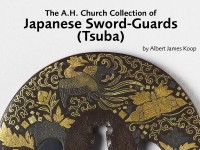The A. H. Church Collection of Japanese Sword-Guards (Tsuba)
An unpublished catalogue of the A. H. Church collection of Japanese sword-guards (tsuba) by Albert James Koop.

About the year 1150 the famqus Munesuke, descendant of a. long line of armourers bearing the family-name of Masuda, was granted the Emperor’s permission to change this name to Miōchin [Japanese text] and founded the celebrated school, already mentioned under Group II, of which twenty-seven hereditary Masters are recorded, besides a host of collateral members and pupils. True Miōchin work on tsuba betrays the smith in the perfection of its iron and the broad, powerful, almost austere dignity of its design. The metal is often treated as it were mere wax, but always with effects entirely suited to the material.
The 17th Master, Nobuiye I [Japanese text] who worked in various provinces, dying in 1564 at the age of 79, stands out from the rest of the Miōchin, producing work which has little resemblance to theirs; thick guards, circular or mokkō in form, occasionally pierced, but more often decorated with bold engraving of octagon diaper (kikkō), botanical and other designs. Nobuiye I was followed by numerous other workers, some bearing the same name, and, as usual, by a host of imitators.
A branch of the Miōchin, working in Echizen province, puts forth its 19th master in the 19th century- all of them signing the same name, Yoshihisa [Japanese text]. Their later work resembles that of the Kinai (Group XVI).
Another branch, dating fiorn the time of Nobuiye I, bears the family-name of Sōtome [Japanese text], but its work generally displays Shōami influence (Group XII).
Nobuiye [Japanese text]
 Tsuba with chequer pattern (EAX.10072)
Tsuba with chequer pattern (EAX.10072)
 Mokkō-shaped tsuba with Buddhist invocation (EAX.10073)
Mokkō-shaped tsuba with Buddhist invocation (EAX.10073)
 Tsuba with radiating devices (EAX.10074)
Tsuba with radiating devices (EAX.10074)
 Mokkō-shaped tsuba with chrysanthemum florets (EAX.10075)
Mokkō-shaped tsuba with chrysanthemum florets (EAX.10075)
 Mokkō-shaped tsuba with five gourds in negative silhouette (EAX.10076)
Mokkō-shaped tsuba with five gourds in negative silhouette (EAX.10076)
 Mokkō-shaped tsuba with foliage, axe, and chariot wheel (EAX.10077)
Mokkō-shaped tsuba with foliage, axe, and chariot wheel (EAX.10077)
 Tsuba with maple leaves (EAX.10078)
Tsuba with maple leaves (EAX.10078)
 Lenticular tsuba with mitsudomoye, or three-comma shapes (EAX.10079)
Lenticular tsuba with mitsudomoye, or three-comma shapes (EAX.10079)
Other Miōchin
 Tsuba with maple leaves (EAX.10080)
Tsuba with maple leaves (EAX.10080)
 Mokkō-shaped tsuba with pearled brass rim (EAX.10081)
Mokkō-shaped tsuba with pearled brass rim (EAX.10081)
 Tsuba in the shape of a bird and with karahana, or Chinese flowers (EAX.10082)
Tsuba in the shape of a bird and with karahana, or Chinese flowers (EAX.10082)
 Mokkō-shaped tsuba with raised edge (EAX.10083)
Mokkō-shaped tsuba with raised edge (EAX.10083)
 Tsuba with 32 radiating lines (EAX.10084)
Tsuba with 32 radiating lines (EAX.10084)
 Tsuba with myōga, or ginger shoots (EAX.10085)
Tsuba with myōga, or ginger shoots (EAX.10085)
 Tsuba in the form of a chrysanthemum flower (EAX.10086)
Tsuba in the form of a chrysanthemum flower (EAX.10086)
 Round tsuba with openwork bands (EAX.10087)
Round tsuba with openwork bands (EAX.10087)
 Cupped tsuba in the form of a clam shell (EAX.10088)
Cupped tsuba in the form of a clam shell (EAX.10088)
 Tsuba in the form of a chestnut (EAX.10089)
Tsuba in the form of a chestnut (EAX.10089)
 Octagonal tsuba with shippō diaper of interlaced circles (EAX.10090)
Octagonal tsuba with shippō diaper of interlaced circles (EAX.10090)
 Octagonal tsuba with smilax plants and matsukawa-bishi, or overlapping lozenges (EAX.10091)
Octagonal tsuba with smilax plants and matsukawa-bishi, or overlapping lozenges (EAX.10091)
 Mokkō-shaped tsuba with dragonfly (EAX.10092)
Mokkō-shaped tsuba with dragonfly (EAX.10092)
 Tsuba with chrysanthemum and plum blossoms (EAX.10093)
Tsuba with chrysanthemum and plum blossoms (EAX.10093)
Yoshihisa [Japanese text] of Echizen
 Tsuba with eight flowers (EAX.10094)
Tsuba with eight flowers (EAX.10094)
 Tsuba with flying cranes (EAX.10095)
Tsuba with flying cranes (EAX.10095)
 Tsuba with two blades of rice (EAX.10096)
Tsuba with two blades of rice (EAX.10096)
 Tsuba with arrow-head and aoi, or hollyhock, leaves (EAX.10097)
Tsuba with arrow-head and aoi, or hollyhock, leaves (EAX.10097)
 Tsuba with fan-palm leaves (EAX.10098)
Tsuba with fan-palm leaves (EAX.10098)
 Lenticular tsuba imitating the design of a helmet (EAX.10099)
Lenticular tsuba imitating the design of a helmet (EAX.10099)
Miscellaneous Miōchin work
Notice
Object information may not accurately reflect the actual contents of the original publication, since our online objects contain current information held in our collections database. Click on 'buy this publication' to purchase printed versions of our online publications, where available, or contact the Jameel Study Centre to arrange access to books on our collections that are now out of print.
© 2013 University of Oxford - Ashmolean Museum





